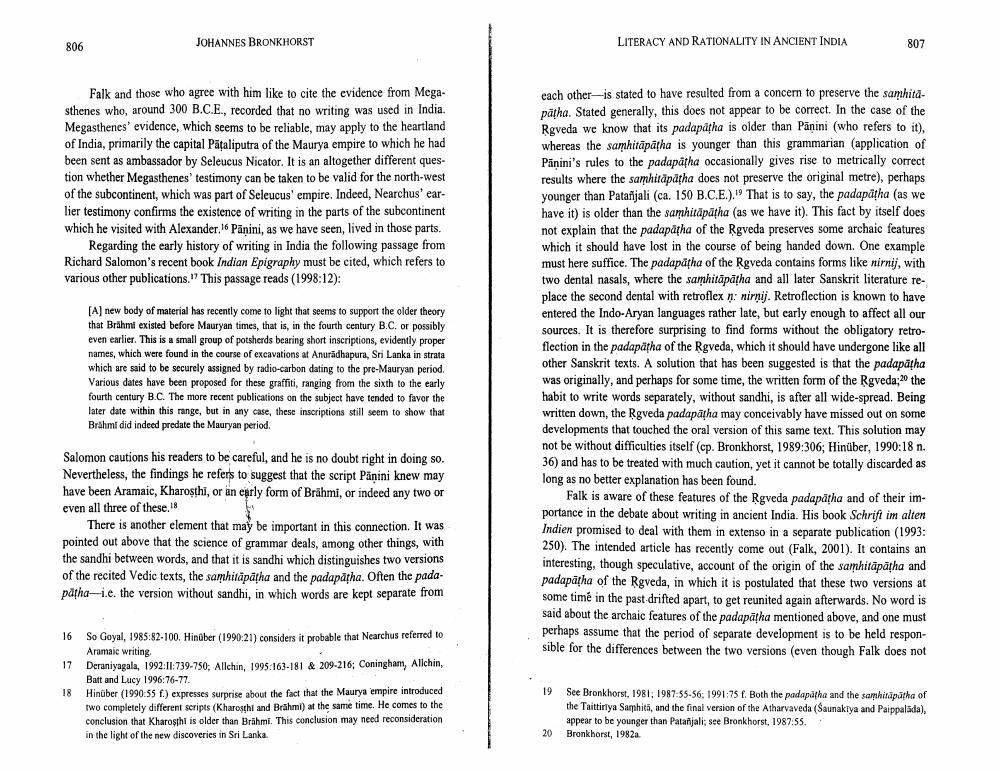________________
806
Falk and those who agree with him like to cite the evidence from Megasthenes who, around 300 B.C.E., recorded that no writing was used in India. Megasthenes' evidence, which seems to be reliable, may apply to the heartland of India, primarily the capital Pataliputra of the Maurya empire to which he had been sent as ambassador by Seleucus Nicator. It is an altogether different question whether Megasthenes' testimony can be taken to be valid for the north-west of the subcontinent, which was part of Seleucus' empire. Indeed, Nearchus' earlier testimony confirms the existence of writing in the parts of the subcontinent which he visited with Alexander. 16 Panini, as we have seen, lived in those parts.
Regarding the early history of writing in India the following passage from Richard Salomon's recent book Indian Epigraphy must be cited, which refers to various other publications." This passage reads (1998:12):
JOHANNES BRONKHORST
Salomon cautions his readers to be careful, and he is no doubt right in doing so. Nevertheless, the findings he refers to suggest that the script Pänini knew may have been Aramaic, Kharosthi, or an early form of Brähmi, or indeed any two or even all three of these, 18
[A] new body of material has recently come to light that seems to support the older theory that Brahmi existed before Mauryan times, that is, in the fourth century B.C. or possibly even earlier. This is a small group of potsherds bearing short inscriptions, evidently proper names, which were found in the course of excavations at Anuradhapura, Sri Lanka in strata which are said to be securely assigned by radio-carbon dating to the pre-Mauryan period. Various dates have been proposed for these graffiti, ranging from the sixth to the early fourth century B.C. The more recent publications on the subject have tended to favor the later date within this range, but in any case, these inscriptions still seem to show that Brahmi did indeed predate the Mauryan period.
There is another element that may be important in this connection. It was pointed out above that the science of grammar deals, among other things, with the sandhi between words, and that it is sandhi which distinguishes two versions of the recited Vedic texts, the samhitapatha and the padapatha. Often the padapatha-i.e. the version without sandhi, in which words are kept separate from
16
So Goyal, 1985:82-100. Hinüber (1990:21) considers it probable that Nearchus referred to Aramaic writing.
17 Deraniyagala, 1992:11:739-750; Allchin, 1995:163-181 & 209-216; Coningham, Allchin,
Batt and Lucy 1996:76-77.
Hinüber (1990:55 f.) expresses surprise about the fact that the Maurya empire introduced
two completely different scripts (Kharosthi and Brahmi) at the same time. He comes to the conclusion that Kharoşthi is older than Brähmi. This conclusion may need reconsideration in the light of the new discoveries in Sri Lanka.
18
19
LITERACY AND RATIONALITY IN ANCIENT INDIA
each other is stated to have resulted from a concern to preserve the samhitapatha. Stated generally, this does not appear to be correct. In the case of the Rgveda we know that its padapatha is older than Panini (who refers to it), whereas the samhitapatha is younger than this grammarian (application of Panini's rules to the padapatha occasionally gives rise to metrically correct results where the samhitäpätha does not preserve the original metre), perhaps younger than Patanjali (ca. 150 B.C.E.)." That is to say, the padapatha (as we have it) is older than the samhitäpätha (as we have it). This fact by itself does not explain that the padapatha of the Rgveda preserves some archaic features which it should have lost in the course of being handed down. One example must here suffice. The padapatha of the Rgveda contains forms like nirnij, with two dental nasals, where the samhitapatha and all later Sanskrit literature replace the second dental with retroflex n: nirnij. Retroflection is known to have entered the Indo-Aryan languages rather late, but early enough to affect all our sources. It is therefore surprising to find forms without the obligatory retroflection in the padapatha of the Rgveda, which it should have undergone like all other Sanskrit texts. A solution that has been suggested is that the padapatha was originally, and perhaps for some time, the written form of the Rgveda;20 the habit to write words separately, without sandhi, is after all wide-spread. Being written down, the Ṛgveda padapatha may conceivably have missed out on some developments that touched the oral version of this same text. This solution may not be without difficulties itself (cp. Bronkhorst, 1989:306; Hinüber, 1990:18 n. 36) and has to be treated with much caution, yet it cannot be totally discarded as long as no better explanation has been found.
Falk is aware of these features of the Rgveda padapatha and of their importance in the debate about writing in ancient India. His book Schrift im alten Indien promised to deal with them in extenso in a separate publication (1993: 250). The intended article has recently come out (Falk, 2001). It contains an interesting, though speculative, account of the origin of the samhitäpätha and padapatha of the Rgveda, in which it is postulated that these two versions at some time in the past drifted apart, to get reunited again afterwards. No word is said about the archaic features of the padapatha mentioned above, and one must perhaps assume that the period of separate development is to be held responsible for the differences between the two versions (even though Falk does not
20
807
See Bronkhorst, 1981; 1987:55-56; 1991:75 f. Both the padapatha and the samhitapatha of the Taittiriya Samhita, and the final version of the Atharvaveda (Saunakiya and Paippalada), appear to be younger than Patanjali; see Bronkhorst, 1987:55. Bronkhorst, 1982a.




